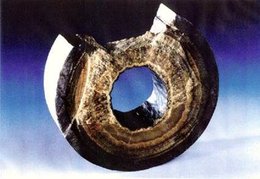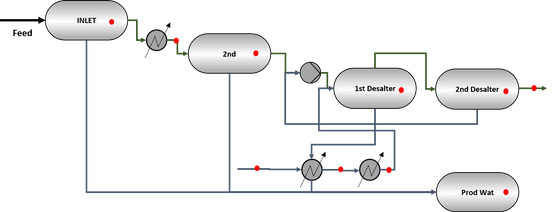Services
Scale Prediction
Scale Prediction
Scale prediction is one of our main activities and we can supply scale predictions and simulations for all types of processes, from traditional well-scale potential simulations to full process simulations. We use our own scale prediction software; ScaleSim.
What is scale?
Scale is formation of solid minerals onto surfaces, for example inside production tubing, in valves, heat exchangers etc. Some typical examples are barite (BaSO4), anhydrite (CaSO4), calcite (CaCO3), siderite (FeCO3), and many others. The picture shows and example of calcite scale in a water outlet pipe from a separator.
Scale prediction
Scale forms as a result of chemical reactions in the produced water when it is exposed to changes in pressure and temperature or when it is mixed with water having a different composition. There will also be interactions between the water and the hydrocarbon phases (oil and gas) and components from the oil/gas may either dissolve in the water or evaporate from the water. A typical example is evaporation of CO2 leading to an increase in pH and carbonate scale formation when pressure is reduced.
To perform a scale predictions it is necessary to:
- Know composition of water phase(s)
- Know composition of oil/gas phases
- Know flow rates and conditions (pressure and temperature and how these vary)
- Have a thermodynamic simulation tool that can describe phase behaviour and properties, calculate compositions and salt solubility as function of composition and conditions. A state-of-the-art scale simulation tool is ScaleSim.
Entering this information into ScaleSim, and it will calculate:
- Which phases that are present and the composition of these (ScaleSim performs a full 3-phase flash calculation)
- Detailed information about water chemistry and concentrations of all aqueous species. This includes pH, amounts of dissolved gases like CO2, H2S, methane etc, dissociation of organic acids and more.
- Scale potential for all common minerals
- Theoretical amounts of salt/scale that can form - and how this influences all other aqueous concentrations and properties.
The results from the simulation will tell if there is a potential for scale formation, what type of minerals and how much. In addition, it is necessary to evaluate the actual risk for scale formation based on scale potential, temperature and other factors. The results are presented in form of tables or graphs, as illustrated below, depending on what is most practical.
Example: Formation water analysis
Scale potential for CaCO3 as function of time at different locations in a topside process. Simulations are based on production profiles.
Scale potential for BaSO4 when mixing injection water (seawater) and formation water. As expected, mixing of sea- and formation water gives huge amounts of BaSO4 precipiation.
Scale simulations of topside process from wellhead, inlet separator, heaters, oil desalting units and oil washing and the final produced water and produced oil streams.
Scale simulations in a oil desalting process. Red show locations where scale potential is calculated.


